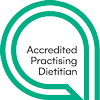Feel Your Fullness
This is the sixth post in a 10-part series looking at the principles of Intuitive Eating. The previous post in this series was on discovering the satisfaction factor.
Next to Honour your hunger, Feel your fullness – the 6th principle of Intuitive Eating – is the other principle that many people focus on when they first hear about Intuitive Eating. It makes perfect sense, given the diet culture we live in with its’ constant messaging that we can’t trust our own bodies and that we need food rules to “stay in control”. However, this principle is not about controlling what you eat. It is about tuning into your body’s unique fullness signals so you can recognise and act on them to prevent the physical discomfort and the feelings of guilt and shame that can arise from eating past comfortable fullness.
This can be one of the most challenging principles to work through if you’ve been a chronic dieter. One reason is that dieting has taught you it’s “OK” to eat at mealtimes which can lead to eating everything on your plate – even if it means eating past comfortable fullness.
If you find you are regularly eating past comfortable fullness, it may be because you have lost touch with your body’s fullness signals which is common after chronic dieting and there may also be some other reasons why this is happening.
Reasons why you might eat past comfortable fullness
Have you ever noticed feeling full at some point during a meal but also felt the need to finish the food on your plate only to afterwards feel physical discomfort? There are many reasons why you may feel the need to finish the food on your plate, even if you later end up feeling physically uncomfortable for it. Here are a few:
You haven’t given yourself true unconditional permission to eat all foods
Respecting your fullness will be challenging if you haven’t made peace with food (principle 3 of Intuitive Eating Make peace with food). It’s much easier to stop eating when you are comfortably full if you know you can eat certain foods or meals again.
This is why, to feel your fullness it’s important to give yourself permission to eat all foods without attaching any conditions (like exercising more, eating less at the next meal or the next day etc.). You need to know and trust you are allowed to eat the foods you desire, when you want them and in the quantities you want and need. So, rather than focusing on trying not eating past comfortable fullness, try shifting your focus to eating foods you enjoy discovering the satisfaction factor and not depriving yourself!
Similarly, if you haven’t given yourself full permission to eat whenever you’re hungry – that is to honour your hunger – then it can be hard to stop when you are comfortably full, if you fear becoming hungry again “too soon.”
You are distracted while eating
Eating while working, scrolling on your phone, watching television, driving etc. makes it difficult to pay attention to your fullness cues. It’s probably also going to be a less satisfying eating experience. When we aren’t satisfied, we are more likely to continue eating more food or fantasise about the food(s) we really want in search of that feeling of satisfaction – even when we are no longer hungry.
You don’t want to waste food
Reducing food waste is a common goal for many people. Remember, there are other ways you can do this without making yourself eat beyond comfortable fullness. For example, you could pack up any leftovers and enjoy them for lunch or dinner the next day.
You were ravenously hungry when you started eating
If you wait to eat until you are really hungry, you will likely feel more urgency to eat and this will make it more difficult to recognise your fullness cues. It will also likely be a less satisfying eating experience. Honouring your hunger can help you avoid becoming ravenously hungry and make it easier to stop when you feel comfortably full.
You have a history of food insecurity
If you have experienced not knowing when you will next eat, it can be even more challenging to stop eating – even when food is plentiful again. You may benefit from working with a certified Intuitive Eating counsellor on this.
You’re not sure what comfortable fullness feels like in your body
Many people describe knowing what it feels like to feel uncomfortably full, but find it difficult to describe how feeling comfortably full feels. One way of finding out is to practice being more present during your meal and to bring more non-judgemental awareness to your eating (see How to tune into your fullness cues below).
Signs you might be approaching comfortable fullness
If you are having difficulty recognising comfortable fullness here are some signs you might be approaching comfortable fullness:
- You feel a gentle and comfortable sense of warmth in your tummy.
- Your eating is slowing down.
- Over the course of a meal, your desire to eat can decrease, leading to eating more slowly.
- Food does not taste as good as it did at the beginning of the meal.
- You feel calmer and more content.
- You are no longer feeling so cranky or grumpy.
- You feel more energised.
- Your thoughts are no longer centred on food and eating.
As you become more in touch with your body, the easier it will become to recognise and act on the cues it sends that signal you are pleasantly full and the less likely it is you will regularly eat past comfortable fullness.
Factors that influence fullness
How much food you need to eat to reach comfortable fullness depends on many different factors including:
- The time elapsed since your last meal/snack. If you haven’t eaten for 4 hours or more, you will need more food to reach feeling comfortably full than if you ate a snack since your last meal.
- The types of food you’re eating. Foods rich in fat, fibre and protein promote fullness.
- If you skip meals or wait too long to eat, you will need more food to reach comfortable fullness. You will also find it more difficult to notice when you’re at that point, so you might end up eating past comfortable fullness.
- The eating context. You might eat more or less when eating with others. You may eat more when eating with others because the meal often lasts longer and we tend to be more distracted from our hunger and fullness cues in social settings. However, social connection while eating is extremely important (see my blog on this sharing meals its-not just about what we eat). Many dieters eat less when they feel like someone is “observing” them.”
The amount of food it takes to reach the point of feeling comfortable full and satisfied will differ from day to day and at each meal. This is because your body’s need for food is not the same every single day. There will be days where you are hungrier than usual, or less hungry than usual. Sometimes it might be obvious why you feel hungrier on a certain day, for example you moved more that day or even the previous day. Other days you will be hungrier, with no obvious explanation. No need to overthink it, just remember to Honour your hunger.
Keep in mind, if you’re hungry an hour or so later, this may also mean you simply aren’t eating enough.
How to tune into your fullness cues
It’s difficult to tell when you have reached comfortable fullness if you are not tuned into recognising fullness cues while you are eating. This is why practicing mindful eating can be helpful when you’re trying to tune into your body’s cues that you’ve eaten enough for you.
A great way to increase your awareness, and more easily recognise when you’ve reached comfortable fullness, is to observe your own eating, as if you were a neutral bystander. To do this, you will likely need to eat without distraction. Here are some tips on how you can start recognising your fullness cues:
- Take a timeout a mid-meal and ask yourself if the food is still tasting good. This can help you determine whether you only continuing to eat because the food still tastes good or because there’s still food on your plate.
- Check in mid-meal with how full you are feeling by asking yourself what your hunger or fullness level is.
- When you finish eating, check in again with your level of fullness. Some people find it easier to start with describing it as pleasant, unpleasant or neutral rather than using a scale of 1 to 10.
When you do this, it’s important not to feel you have to leave food on your plate, since this can lead to a sense of food scarcity and reacting to that sense of food scarcity by eating past comfortable fullness. Sometimes there might still be food on your plate when you’ll reach comfortable fullness and sometimes you will be hungry enough to eat everything on your plate.
A word on fake fullness versus real fullness
“Fake fullness” happens when you try to fill up on food (or liquids) that have volume, but provide little to no energy. Some examples might be rice cakes, celery or carrot sticks, water or calorie-free beverages. Ironically, many people tend to use foods and drinks like this to “fill up” and avoid the very foods that might help them feel full – foods containing protein, fat, fibre and carbohydrate.
Try this hack: look at your plate before you eat the food on it. Do you have some foods rich in carbohydrate, protein and fat on your plate? If not, consider adding or increasing the amount of foods rich in carbs, protein and fat. Over time try adjusting the amounts and proportions of these and experiment to see what works best for you.
Food can be filling without being satisfying
Feeling full and feeling satisfied are two different things. Remember, if you’re eating is based on food rules you can be full but not satisfied, but you probably won’t be satisfied without feeling a sense of fullness. If you want to refresh your memory on this – check out my previous post: discovering the satisfaction factor
Short and sweet
Instead of trying to force yourself to stop eating when you are full, focus on Honouring your hunger, eating consistently, Making peace with food and eating foods you find satisfying. If you can do this, you will reach a place where you just naturally feel “done” eating – no control needed.
Initially, you might find yourself eating past comfortable fullness. This is normal and will decrease over time as you make peace with food, eat consistently, start feeling more satisfied by your food choices and have some additional ways of coping with your emotions.
Be gentle and patient with yourself. It takes time experimenting to gauge your body’s hunger and fullness cues. Some days you might eat more than feels good, sometimes less. Don’t think of this as “not doing it right” – it is totally normal to eat past comfortable fullness on occasion and when it comes to Intuitive Eating, there are no rules, no right or wrong, just opportunities to learn.
Ready to take the next step? Contact me and request a complimentary call to find out more about Intuitive Eating and how it can help you truly nourish yourself – body, mind and soul.






